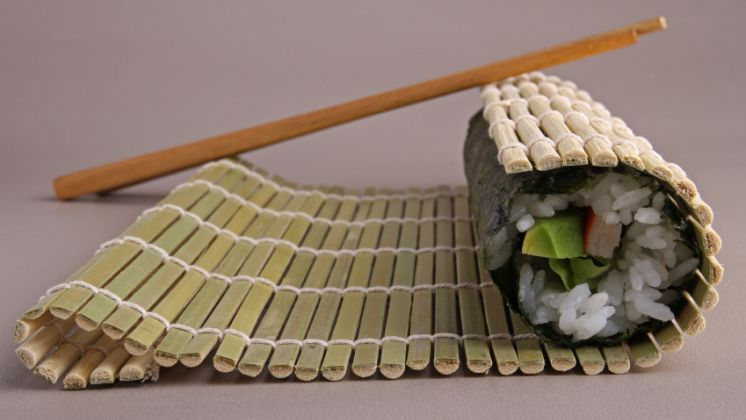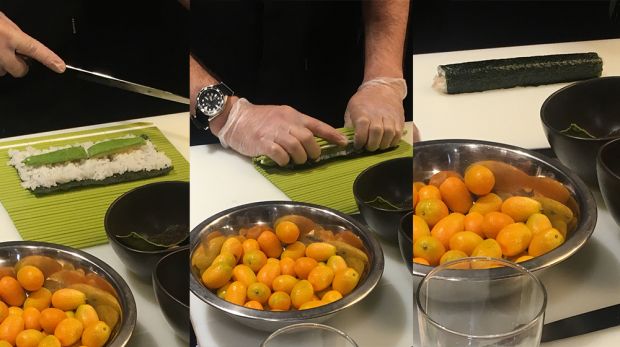How to Make Sushi at Home
Coach gets to grips with how to make sushi

How to Make Sushi at Home – The Short Version
The Japanese diet has been eyeing up the Mediterranean’s healthy eating crown for some time, with the remarkable longevity of the Asian country’s residents backing up the idea that its fish-heavy diet ticks all the nutritional boxes required.
To adhere to a Japanese diet clearly involves more than indulging in sushi, you’re going to need a lot more vegetables for starters, but it’s a first step. And despite the hefty whack of salt and white rice involved, it’s a healthy lunch option, especially the omega-3 rich fish, which also brings in a dollop of “good” unsaturated fats. Home-made sushi, however, is a daunting proposition. Sushi chefs will train for years to perfect their craft and avoid any Homer Simpson/blowfish debacles. Coach attended a Sushi Shop masterclass to try to get some pointers on wrangling raw fish into presentable bundles – here’s what we learned.

- Lay your sheet of nori (seaweed) on your makisu (mat), rough side up. Leave about an inch rice-free at the top of the sheet. You want an even layer about half a centimetre thick, get rid of any extra rice at this stage, because it’ll be too late once you start rolling.
- Add your ingredients in a line in the middle of the rice, and then it’s rolling time. You’re aiming for gentle but firm movements, pressing the roll into a squarish shape. The makisu will help. Use it by placing your unrolled nori on top and rolling it with the mat, ensuring you get some seaweed-on-seaweed contact to ensure the roll sticks.
- Then chop your roll into pieces, grab some wasabi, soy and ginger, and enjoy.
If your home-made sushi attempts yield nothing but a great deal of mess, then you can turn to Sushi Shop’s new 42-piece Football Club Box for an expertly crafted meal to enjoy during the closing stages of Euro 2016. £45, mysushishop.co.uk.
How to Make Sushi at Home – The Masterclass
Sushi is bloody lovely. Luckily, it's also bloody healthy. That’s thanks to the combination of fresh, natural ingredients and emphasis on fish, which is packed with good stuff including muscle-building protein, omega oils and a host of nutrients that do everything from boosting immunity to aiding muscle recovery and promoting good joint and bone health.
The only problem with sushi is most of us are getting it horribly wrong. Pre-packaged supermarket sushi might make a passable snack or last-minute lunch, but compared to real sushi it's an abomination. Now, we might sound all high and mighty here, but it's hard not to after we visited a proper sushi restaurant in London called Kouzu and tasted the most incredible sushi that's ever passed our lips. We instantly swore never to eat the low-grade stuff again and got chatting to sushi chef Ryu while we were there.
Here, Ryu shares his tips for making your own incredible sushi at home. You’ll never have to squeeze soy sauce out of a tiny fish ever again.
How do I prepare to make sushi? What do I need?
Making sushi means including two main elements: fish and seasoned rice. Normally, sushi rice is mixed with a vinegar blended with salt and sugar in a large wooden container. However, a large shallow dish and a wooden spoon will be fine as an alternative to mix the rice with (try not to mix the rice too much as it will become sticky).
Sushi rice is usually made using shortgrain white rice to achieve the fluffy and sticky texture, however, it's been popular as of late to use shortgrain brown rice as a healthier and more nutritious substitute. Sushi has evolved from its traditional roots of using preserved fish and nowadays more kinds of fish are available, as well as vegetarian options and even meat. So, why not experiment with what ingredients you want to use in your nigiri (hand formed sushi) or maki (rolled sushi)?
Nori (dried seaweed paper) are available in local supermarkets, or specialist Asian markets where you can also buy pre-made sushi vinegar, wasabi powder (which forms a paste as you mix with water) or paste, and a sushi rolling mat (traditionally known as makisu).
Be sure to wet your hands (not too much) before handling sushi rice, and wait for the rice to reach body temperature before using to ensure the best taste. Keep the sushi rice in a small Tupperware box with a moist cheese cloth to cover the rice before putting the lid on to prevent the rice getting soggy.
Where should I buy my fish, will supermarket stuff do?
Fresh fish must always be sashimi grade. Your fishmonger will be able to advise you whether their fish is of that standard. Places like Atariya and Japan Centre in London do sell easy to use/cut fish fillets especially for making sushi at home, but these should be a last resort as they perish fairly quickly and do require a certain skill to handle (otherwise becoming a professional sushi chef wouldn’t be notorious for taking so long). Smoked salmon and crabsticks are a good example of safer alternatives.
Is there an easy way to tell the freshness of the fish I buy?
When looking at fish the easiest way to tell the freshness is the firmness of the meat especially the belly part, the scales and eyes should shine proudly and the gills should be ruby red. Fillets of fish must look vibrant in colour (for fish such as salmon and tuna), while white-fleshed fish such as sea bass should not be opaque but translucent. Be sure to stay away from any fish that smells even remotely fishy and looks limp or watery.
What's the difference between sushi and sashimi - is one harder to make?
Sushi is the joining of fish with sushi rice, whereas sashimi is simply sliced fish on its own. Both are difficult to master, but fun to learn. Sushi is judged on many factors: the shape and texture of the rice as well as the beauty of the cut, the balance and consistency of the sushi made, and finally how the chef cares for all the elements involved in the process. Sashimi is also very difficult as a single gram can change the outcome of the way the fish tastes, too thin and you can be left feeling unsure what you've just eaten, too thick and the taste can be overwhelming.
To achieve the perfect cut, you must constantly keep your knife sharp and learn the dynamics and science behind slicing fish on a molecular level. Simply put, a sharp knife cuts through the cells cleanly without damaging the contents within, while a blunt knife and poor skills will crush the cells releasing the contents and causing the fish to essentially perish quicker when being exposed to air. Have you ever seen those samurai films where one draw of the blade can leave the item temporarily seem uncut till it suddenly falls apart seconds later? This is the dexterity and skill needed to give sashimi its beautiful shiny surface. Watch tutorial videos on YouTube to get an idea of the basic skills required. Also, come to a top sushi restaurant such as Kouzu, sit at the sushi bar, watch the chef and ask questions.
What are the main mistakes people make when making sushi/sashimi and how can they be avoided?
Using shortgrain rice is a must as it's the necessary texture to make sushi. Try not to use too much rice when making sushi as you mainly want to taste the fish. Sashimi size is dependant on what fish you wish to use. Coloured fish can be a bit thicker around half to one centimetre in size, whereas white fish needs to be cut thinly, to avoid toughness as the smaller fish have more fibres in their flesh. Always cut sashimi against the grains of the fish, this is very important to make it melt in your mouth and not be chewy.
Can you explain the process for making a really simple, yet amazing tasting piece of sushi/sashimi?
- You will need a scale to be serious on this one. To make nigiri use around 10g of sushi rice and 12g of white fish (15g of coloured fish).
- Place a smidge of wasabi paste on the less attractive side of the cut fish. Use your other hand to make a nice ball shape and gently but firmly attach them together and shape into a nice size.
- Be sure not to take too long when forming and ensure that your hands are quite cold and fairly wet.
- Making rolls is always the best option, in my opinion, for sushi at home, because it's fun and a lot more likely to come out sucessful and you can use virtually any ingredients you like.
- Wrap the sushi mat in clingfilm loosely to keep clean.
- Place the nori on the mat, rough side facing up, as there are two different surfaces on the sheet of seaweed.
- Spread around 100g of sushi rice over the seaweed and sprinkle anything you want on the outside of the roll. Sesame seeds are a good option.
- Next, place the ingredients you want in the roll and use the mat to form a maki - done by folding over twice.
- Try to imagine a square shape when making the roll. The rice will expand over time to make a round shape later.

Nick Harris-Fry is a journalist who has been covering health and fitness since 2015. Nick is an avid runner, covering 70-110km a week, which gives him ample opportunity to test a wide range of running shoes and running gear. He is also the chief tester for fitness trackers and running watches, treadmills and exercise bikes, and workout headphones.
